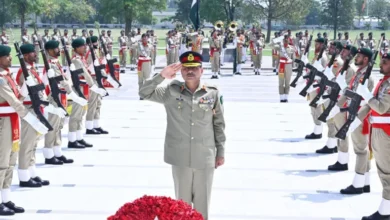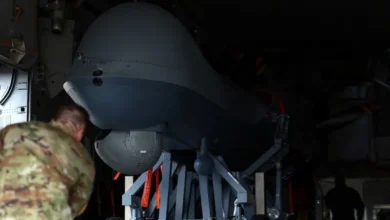Analysis: Is the Israeli army as militarily successful as it claims?

Coordinated, focused, deadly and brutal, the Hamas attacks of October 7 were a shock to Israeli society. The country’s defence, intelligence and security organisations – sources of national pride – were caught unawares and unprepared.
They acted slowly and inadequately, with the whole establishment humiliated.
The first military reaction was in line with the Israeli military doctrine of powerful attacks against previously designated targets. It took a few days for everyone to get their act together, create the emergency unity government (that mostly unified belligerent right-wingers) and proclaim a huge mobilisation of 360,000 reservists.
Three weeks later, amid continuous indiscriminate bombardment, the Israeli army crossed into Gaza. Then, in more than two months of ground combat, the army cut Gaza in three, surrounding Gaza City and isolating Khan Younis. Most Palestinians fled to the south, where they now crowd Rafah in unbearable conditions.
Israel maintains that although it has not yet defeated Hamas, it is close to its proclaimed goal, claiming to have “eliminated” 8,500 fighters.
The Israeli military’s showing, however, has been very uneven across many aspects of the armed and diplomatic response.
Military performance: Not a failure, but far from success
In purely military terms, Israel has achieved a degree of success. It has conducted complex military operations in urban terrain, certainly the deadliest form of warfare, by advancing steadily – yet too cautiously and slowly.
The centres of Gaza City and Khan Younis are surrounded on the ground, but the military has so far failed to neutralise Hamas fighting units.
In an extremely challenging battle environment, the Israeli army successfully integrated many different units of various backgrounds, training and experience – including a plethora of specialised units that report directly to the General Staff outside of the normal territorial or brigade chain of command.
Those complex arrangements demand the presence of higher officers on the front lines to coordinate and avoid potential confusion. Among the 172 Israeli soldiers killed so far, the proportion of senior non-commissioned officers is unusually high, but the number of officers who died in battle is staggering, with no less than four full colonels among the dead.
Hamas’s losses are certainly lower than Israel claims. A prudent estimate would put it at 3,500 fighters to date – 20 percent of its front line complement. This would mean a ratio of 20 Hamas fighters killed for each Israeli soldier.
In classic warfare, any general would happily accept that proportion as a certain victory. However, not in this war. Hamas fighters are ideologically and religiously motivated, and conditioned to disregard death; the fallen are seen as martyrs, which strengthens the cause.
In contrast, Israeli society, which is heavily militarised – almost everyone, except the ultra-religious, serves in the military – has a lower tolerance for the losses of its people. Israelis do not see the tangible results of their sons’, husbands’ and brothers’ deaths.
The attitude towards losses is probably best demonstrated by the fact that the Golani Brigade, one of the army’s oldest and most decorated units, was pulled from fighting after 72 of its soldiers died in combat.
Finally, Israeli forces who claimed their overwhelming military (and moral) superiority, proved to lack either the capabilities or the willingness to decisively destroy the Hamas tunnel network. Despite demonstrating the mastery of technology to flood tunnels with seawater, the Israelis have yet to deploy that tactic.
Liberation of captives: Abject failure
Besides destroying Hamas, the other main proclaimed goal of the Israeli incursion into Gaza was to liberate the remaining captives. Not only has this aim not been achieved, but Israel managed to kill three captives who tried to give themselves up.
Military technology: Very good, but non-decisive performance
In many aspects of military technology, the Israeli military is known as a world leader. Most of its hardware and software perform to the army’s own high expectations, which will certainly boost its post-war exports and help, at least, to partially offset the staggering cost of war.
New weapons and systems have been successfully integrated with old ones. The Israeli-built Eitan armoured fighting vehicle was rushed into action a year before its planned introduction into combat units without issue. New products, like the Iron Sting smart mortar, and small, simple and cheap reconnaissance quadcopter drones, have proved valuable in reducing losses in urban fighting.
Existing products have demonstrated their versatility and become widespread: small body cameras and gun cams are now deployed on all teams; dogs with live cameras have expanded the possibilities of reconnaissance inside buildings suspected of being booby-trapped.
Another undoubted Israeli military success is managing to keep its combat data link communications secret, encrypted in real time – there has been no hint of compromise by Hamas. The already-proven Iron Dome antimissile system has continued to be reliable.
Just a few weapons have had issues, such as the much-touted Trophy armoured vehicle active protection system, which proved of mixed or no value in close-quarter combat. Initial overreliance on it cost the Israeli army some casualties in the first phases of the battle.
But the Israeli army’s learning curve has been steep and, like in the case of the Merkava tank’s lack of protection from above, remedial action has been applied quickly and successfully. Despite the military’s operational success, none of its technology proved to be a real game changer.
Public relations: A disaster despite all efforts
The notorious overwhelming Israeli propaganda machinery has tried very hard to sell its official line but with limited success. Calling Hamas “terrorists” caught on in much of the Western world – not as much for the rest of the planet.
Attempts to equate Hamas with ISIL (ISIS), an effort aimed particularly at the Arab and Islamic world and reinforced by Israeli military spokesperson Lieutenant Colonel Avichay Adraee to the Arab world, appear to have failed miserably.
But Israel’s biggest failure was the attempt to make the world believe the claim that “Israel is committed to minimising civilian harm and abiding by international law”.
Even Israelis themselves have questioned those claims. Videos of purported Hamas fighters, which showed men – many who were overweight, unfit and older than 40 – surrendering to Israeli forces stripped to their underwear, were laughed at and eventually rebuked.
Statements intended to dehumanise Palestinians, like their description as “human animals”, made — among others — by Israeli Major-General Ghassan Aslian, ironically a Druze officer, resulted in more revulsion than solidarity. The Druze are an Arab minority group who have faced discrimination within Israel.
However, the biggest failure of the Israeli military campaign must be its deliberate, disproportionate and brutal overreaction – one that has killed tens of thousands of civilians.
The exact number would depend on how many Hamas fighters are among the 21,800 killed so far. If the Israeli claim of 8,500 Hamas fighters is true, that would still mean that 13,300 civilians, including 8,600 children, have been killed. If Hamas has lost 4,000 people – a figure I find much more credible – the number of civilians who have been killed intentionally or by the negligence of the Israeli military is well above 17,000.
That number is considered unacceptable, under any conditions, by many people across the globe who believe that whenever and however the war ends, those dead civilians will come back to haunt the whole of Israel.










